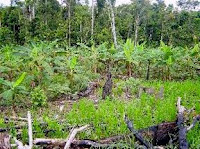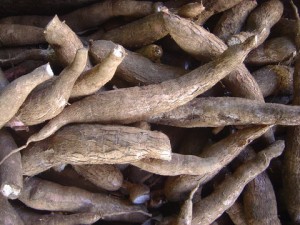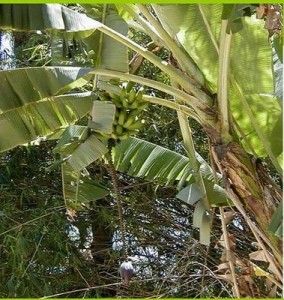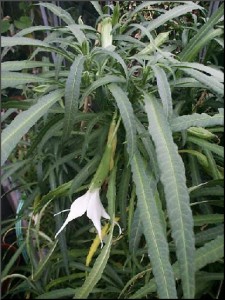 |
| Chacra planted with rice and plantains adjacent to mature forest |
Of central importance in ribereño life is the chacra, the swidden or slash-and-burn garden. This is true also of many Amazonian peoples, for whom gardens — and garden magic — are a central feature of the domestic economy. A chacra is made by clearing an area of forest, burning the felled trees and other vegetation, clearing the movable remaining vegetation and reburning it, and then planting yuca, manioc, cassava (Manihot esculenta), plátano, plantain (Musa paradisiaca), and other cultivated plants and trees such as beans, palms, pineapples, papaya, and mango. After several years, when the nutrients derived from the ash have been exhausted, the garden is abandoned to become new growth jungle, and a new garden is created. Such gardens frequently demonstrate a sophisticated understanding of ecological interrelationships among domesticated and wild plant species.
Yuca is a staple crop for small swidden agriculture and a primary source of carbohydrate in the Amazon. All yuca roots contain a poisonous cyanogenic glycoside. The two kinds of yuca — dulce, sweet, and brava, bitter — differ in how this chemical is distributed. Sweet yuca can be eaten simply by peeling off the bark and boiling the root. In bitter yuca the poison is spread throughout the root, and must be extracted before consumption; this is done by peeling and grating the root, and then squeezing out the poisonous juice in a long mesh sleeve that serves as a yuca press. The two varieties are not clearly different in shape or color, so they can be difficult for the unsophisticated to tell apart. Often it is simply a matter of knowing which type was planted; but, in addition, sweet yuca has two easily removable skins, a thinner outer one and a thicker inner one, while bitter yuca has a single skin which is difficult to remove.
 |
| Yuca, manioc, cassava (Manihot esculenta) |
Among indigenous peoples of the Upper Amazon, cooked yuca is thoroughly chewed by the women and spit into a pot, where it ferments into masato, a virtually universal recreational drink, regularly offered in hospitality and not to be refused. Drinking masato — and it really is as awful as it sounds — is so common that a wife will make her husband his own masato bowl, which he carries with him when visiting friends or neighbors. When I was living with the Shapra Indians, I knew I had been accepted when I was given my own masato bowl to carry with me.
 |
| Plátano, plantain (Musa paradisiaca) |
Plátano, another staple source of carbohydrate, is eaten boiled or fried. Although sometimes called banano, these are plantains, not bananas. For reasons I do not understand, the people among whom I have lived in the Amazon call bananas manzanos, apples, or manzanitos, little apples. It is surprisingly difficult to find bananas in villages in the Upper Amazon. Plantains are distressingly common, eaten at almost every meal. Roasted plantains are tasteless and dry, and I got really tired of them; fried plantains are generally more palatable, but may be forbidden during la dieta. It was a great treat when someone would bring a bunch of sweet bananas in from the jungle.
Shamans not infrequently plant their own sacred and healing plants, primarily ayahuasca, chacruna, toé, and mapacho. Don Rómulo Magin, for example, had a large bush of sameruca growing in his front yard, which he would use to prepare his ayahuasca drink. Almost all the shamans in Colombia use ayahuasca vines that are deliberately planted for their use in healing ceremonies.
 |
| Culebra borrachero (Methysticodendron amesianum) |
Indeed, all the forms of toé in the Amazon are considered to be cultivars. Ethnobotanist Wade Davis points out that the grotesque forms of many of these cultivars, generally called borrachero in Colombia, “are caused by viral infections. The Indians note that the varieties breed true and that each has quite specific pharmacological properties that can be manipulated by the shaman.” These borrachero cultivars are given distinct names — munchiro borrachero, culebra borrachero. Indeed, a small tree containing high concentrations of scopolamine, Methysticodendron amesianum, may not be a distinct genus at all, but rather a highly atrophied form of toé — the result of a viral infection or mutation recognized and cultivated for its psychoactive effects.
A chacra is a cleared space, limpia, clean, just like the ubiquitous soccer field or the wide clear path leading into the village from the riverbank — plantless, the result of human action, nonjungle. On the other hand, the monte is, to the mestizo, the place of least human cultural interference, the place of jungle spirits and wild Indians. They are wild because they live away from the rivers and out of contact with riverine commerce, in the center of the jungle; they are naked and they eat their food raw and without salt. In short, they live with a minimum of cultural mediation between the jungle and themselves. Indeed, one regional dictionary defines the word monte as despoblado, unpopulated, deserted, as if there was no one in the jungle at all.

- Previous Post: Beat Ayahuasca
- Next Post: Plant Knowledge
- More Articles Related to: Indigenous Culture, The Amazon


